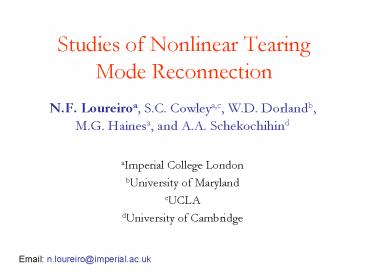Studies of Nonlinear Tearing Mode Reconnection - PowerPoint PPT Presentation
1 / 18
Title:
Studies of Nonlinear Tearing Mode Reconnection
Description:
II - Rutherford ( 73) Island grows linearly in time ... Waelbroeck ( 89, 93) generalised Rutherford's theory in the h=0 limit for when ... – PowerPoint PPT presentation
Number of Views:67
Avg rating:3.0/5.0
Title: Studies of Nonlinear Tearing Mode Reconnection
1
Studies of Nonlinear Tearing Mode Reconnection
- N.F. Loureiroa, S.C. Cowleya,c, W.D. Dorlandb,
M.G. Hainesa, and A.A. Schekochihind - aImperial College London
- bUniversity of Maryland
- cUCLA
- dUniversity of Cambridge
Email n.loureiro_at_imperial.ac.uk
2
Introduction
- Tearing mode is spontaneous (i.e., non-driven)
magnetic reconnection in the presence of a
strong, out-of-plane, magnetic field (guide
field). Occurs in tokamaks, the Sun, etc. - A complete description of the tearing mode
nonlinear evolution is still missing. The
picture is especially unclear in the WD 1
regime.
3
The global picture
4
The Tearing mode instability
- The tearing instability is one of the best known
paradigms for spontaneous reconnection. - Perturb initial equilibrium
- In MHD, system is unstable if
- In MHD, the tearing instability is a function of
2 parameters only
Growth rate
5
RMHD Equations
2D Reduced-MHD (Strauss 76). Valid when
Equations are numerically integrated.
Pseudo-spectral code, ABM 4th order time
integration scheme, parallelization using
MPI. D is varied by changing the aspect ratio
of the simulation box
Linearize and solve for perturbation y1(x).
Obtain with
6
Traditional view of the tearing mode
- D must be small (Logic system was previously
stable - something causes D to increase as soon as Dgt0,
system unstable. ) - Therefore, constant-y approximation is valid
Three distinct stages I - Linear (FKR, 63)
Island grows exponentially in time. II -
Rutherford (73) Island grows linearly in
time III - Saturation (White, 77 Escande
Ottaviani (04) Militello Porcelli(04))
Island growth stops.
i.e., nonlinear evolution on the resistive time
scale (very slow), doesnt really explain
observations. Not very exciting
7
Case for large D
- Preliminary measurements of D for the sawtooth
instability in MAST indicate
(Turri et al.) - It is known (Migliuolo et al., 91) that kinetic
effects can raise the tearing instability
threshold to - Long and thin Sweet-Parker-like current sheets,
observed in experiments such as MRX, are known to
be unstable. These will have very large D.
8
Large D results
By increasing D, a completely different
evolution is observed.
9
Large D results
Speed up of the growth rate is accompanied by
outflow acceleration to Alfvénic velocities.
This is fundamentally different from standard
tearing mode picture, in which saturation is
achieved directly from the Rutherford regime.
10
Stage III - Waelbroeck transition
Waelbroeck (89, 93) generalised Rutherfords
theory in the h0 limit for when constant-y is
invalid, i.e., DW1. Finds that X-point is
replaced by a current sheet. Faster reconnection
ensues. At early times, DWltlt1 so constant-y
valid. As the island grows, this no longer holds.
Transition happens at
11
Stage III - Collapse
12
Stage III Exponential SP reconnection
We find that the collapse proceeds exponentially,
at the Sweet-Parker rate
Therefore, by increasing D, we are able to
obtain exponential, nonlinear reconnection, which
can proceed at rates faster than linear.
13
Stage IV- Current sheet (in)stability
A linear analysis (FKR) of the current sheet
shows that they should become unstable if their
aspect ratio Agt2p. However, current sheets with
much larger aspect ratios are observed both in
experiments and in simulations. Bulanov et al.
(79) argued that flows along the current sheet
would have a stabilizing influence on the
sheet. Assumed linear flow profile and performed
FKR-type linear analysis on the new setup.
14
Stage IV- Plasmoid generation
15
Stage IV Plasmoid growth and coalescence
16
Stage V - Saturation
Whites saturation theory (77) has recently been
revisited by Escande Ottaviani (04) and
Militello and Porcelli (04). They arrive
at Only valid for small D. No theory exists at
large D.
These results show that the existence of a
collapse has a direct impact on the saturation
amplitude. But Influence of boundary conditions
needs to be assessed.
17
Minimum D for collapse
For collapse, we must have
In our case this gives Dgt5.2 In good agreement
with extrapolation from current sheet length
measurements
18
Conclusions
- Classic evolution of the tearing instability
happens only in a narrow region of parameter
space. - Two timescale behaviour is possible even within
the simple resistive RMHD framework. - Large D tearing instability is multi-staged and
highly complex. - Collapse of the X-point structure gives rise to
current sheet and exponential SP reconnection. - Plasmoid are born out of tearing instability of
the current sheet. Collapse process has
self-similar nature. - At low D, saturation is very well described by
recent theories. At large D, collapse causes
jump in the saturation amplitude. - Acknowledgements This work was funded by
Fundação para a Ciência e a Tecnologia through
grant SFRH/BD/2785/2000.

